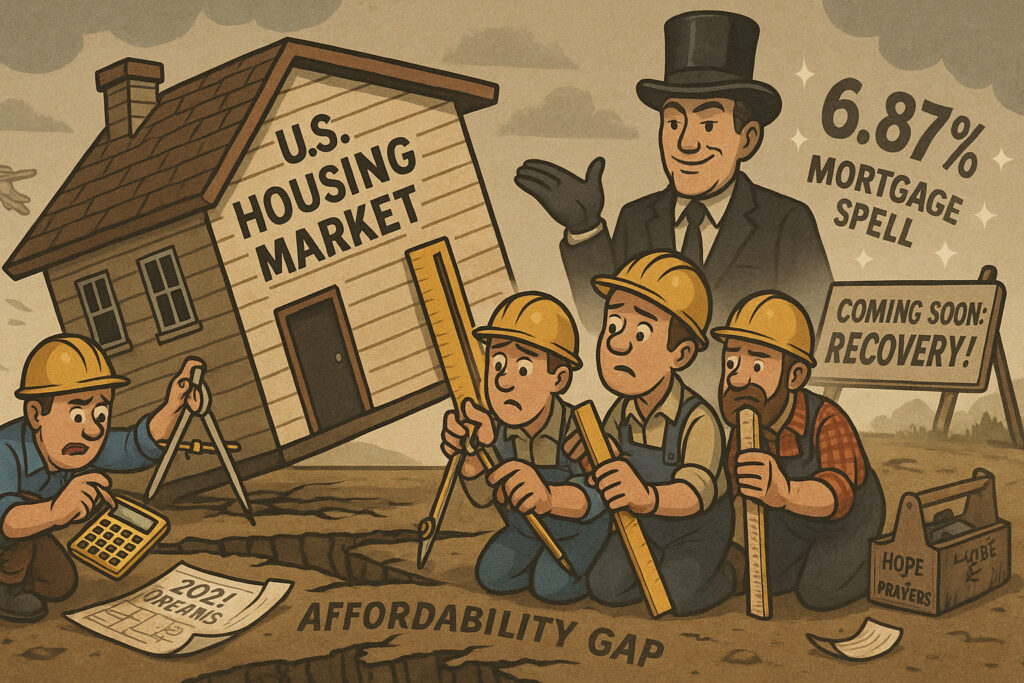The U.S. housing market, once a shining beacon of post-pandemic economic recovery, is now flashing warning signs. On April 18, 2025, the U.S. Census Bureau released the latest data showing a sharp decline in March housing starts, down 13.7% month-over-month to a seasonally adjusted annual rate of 1.32 million units, missing market expectations of 1.48 million. This marks the steepest drop since early 2020 and raises critical questions about the sustainability of the real estate sector amid lingering high interest rates and cooling demand.
Housing Starts Data Breakdown
March’s figures revealed a broad-based slowdown:
- Single-family housing starts declined by 9.8% to a rate of 879,000 units.
- Multi-family starts (buildings with five units or more) plummeted by 24.5%, registering 421,000 units.
- Building permits, a forward-looking indicator, also fell 5.4% to an annualized pace of 1.44 million, suggesting further weakness ahead.
Regional data accentuated the trend:
- Northeast: -17.5%
- Midwest: -12.3%
- South: -15.0%
- West: -10.2%
Every region reported double-digit declines, underscoring the nationwide nature of the housing market retreat.
Key Drivers Behind the Slump
1. Elevated Mortgage Rates
Despite the Federal Reserve signaling a pause in rate hikes earlier this year, mortgage rates remain stubbornly high. The 30-year fixed mortgage hovered around 6.87% as of mid-April, according to Freddie Mac. Higher borrowing costs have priced many first-time buyers out of the market and cooled speculative demand.
2. Tight Credit Conditions
Banks, reacting to higher rates and economic uncertainty, have tightened lending standards, making it more difficult for both developers and homebuyers to secure financing.
3. Persistent Affordability Challenges
The National Association of Realtors (NAR) reported that the median existing-home price climbed back above $400,000 in March, exacerbating affordability challenges. High home prices, combined with elevated mortgage rates, have created a “double whammy” effect on demand.
4. Softening Labor Market
Recent upticks in jobless claims, coupled with slowing payroll growth, are dampening consumer confidence. With economic uncertainty looming, potential homebuyers are increasingly reluctant to make large financial commitments.
Market Reactions
Equities
- Homebuilder stocks tumbled following the release:
- DR Horton (DHI): -3.2% to $114.80
- Lennar Corp (LEN): -2.7% to $127.65
- PulteGroup (PHM): -3.5% to $94.10
The SPDR S&P Homebuilders ETF (XHB) dropped 2.9%, reflecting broad-sector weakness.
Bonds
- The 10-year Treasury yield slipped 5 basis points to 4.11%, as investors sought safety amid growing concerns about economic softening.
Commodities
- Lumber futures fell 2.4% to $486 per thousand board feet, reflecting expected weakening in construction activity.
Expert Commentary
“Today’s housing starts report is a clear sign that higher borrowing costs are taking a toll,” said Sarah Williams, Chief Economist at SunTrust Advisory. “Unless mortgage rates fall meaningfully, we expect housing activity to remain under pressure throughout 2025.”
“The silver lining,” added Tom Lewis from Moody’s Analytics, “is that a housing slowdown could help cool inflationary pressures, giving the Fed more flexibility later this year.”
Implications for Broader Economy
GDP Growth
Housing is a critical component of GDP through residential investment. A sustained decline in starts could shave 0.3-0.5 percentage points off annualized GDP growth in Q2 and Q3, according to Barclays Research.
Inflation
Weaker demand could translate into slower home price appreciation, helping to moderate shelter inflation, which has been a stubbornly high component of core CPI.
Monetary Policy
While the Fed remains data-dependent, signs of cooling in the housing sector, alongside softer labor data, may strengthen the case for a rate cut later in 2025. Fed Funds Futures now price a 52% probability of a 25-basis-point cut by September, up from 45% before today’s housing data release.
Looking Ahead: Can Real Estate Stabilize?
Potential Tailwinds
- Lower Rates Later This Year: If inflation continues to trend lower, the Fed could ease monetary policy, providing relief to mortgage rates.
- Supply Shortages: Chronic underbuilding since the Great Financial Crisis still means that the U.S. remains millions of units short of meeting housing demand.
- Millennial and Gen Z Demand: Demographic trends suggest that underlying demand remains strong over the medium term.
Risks to Watch
- Further Economic Weakness: A deeper-than-expected recession would exacerbate the housing downturn.
- Credit Tightening: Ongoing banking sector stress could restrict access to construction and mortgage financing.
- Policy Changes: Unanticipated regulatory shifts could impact affordability or construction activity.
Conclusion
The sharp decline in March housing starts offers the clearest sign yet that the U.S. real estate market is no longer insulated from broader economic headwinds. While fundamental demand remains, high mortgage rates and affordability issues are causing a material cooling in activity.
Investors should remain cautious on homebuilder stocks in the near term but look for opportunities should signs of stabilization emerge later in the year, particularly if monetary policy turns more accommodative.
Ultimately, real estate is rolling over, but whether this marks a soft landing or the beginning of a more severe downturn will depend heavily on macroeconomic developments over the coming months.
